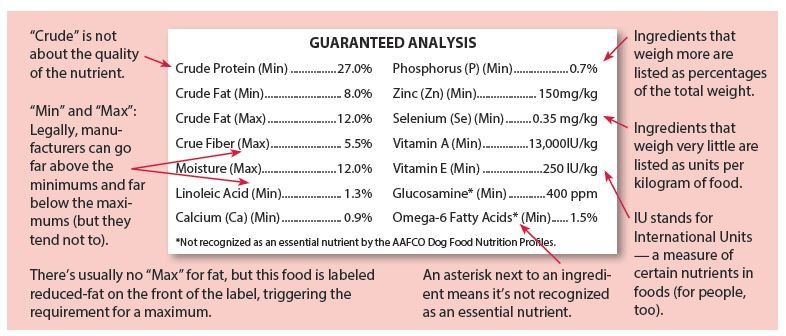
Deciphering Dog Food Labels: What's In Dog Food
Figuring out what brand and type of dog food are best for your beloved pup can be a little intimidating. With hundreds of options, picking "the right" one may seem overwhelming. Add in the technical jargon put on labels, and you've got a recipe for confusion.
Let's take a look at what goes into dog food labels.
Who's In Charge?
First, the FDA regulates all pet food labels, and some states have their own regulations. The standards provided by the Association of American Feed Control Officials (AAFCO) have been adopted alongside FDA guidelines in many states.
"The federal regulations, enforced by the United States Food and Drug Administration (FDA), establish standards applicable for all animal feeds: proper identification of product, net quantity statement, manufacturer's name and address, and proper listing of ingredients . . . These [AAFCO] regulations are more specific in nature, covering aspects of labeling such as the product name, the guaranteed analysis, the nutritional adequacy statement, feeding directions, and calorie statements." - FDA
What's In A Name?
The AAFCO has set very easy to follow rules for naming conventions; the 95% rule, the dinner rule, the "with" rule, and the "flavor" rule.
The 95% Rule
The 95% rule applies to food that has a small number of ingredients. These foods usually have straightforward names like "Chicken for Dogs" or "Beef Dog Food." At least 95% of the food must be the named ingredient (Chicken in "Chicken for Dogs) when not counting the water added. When considering the water added for processing, the named ingredient must still make up at least 70% of the food.
If the name is composed of two or more ingredients, such as "Beef and Chicken Dog Food," the combination of those two ingredients must be at least 95% of the food's total proportions.
When looking at the ingredients list, the ingredients are ordered by percentage of weight included in the food. So this means if you're looking at "Beef Dog Food," the ingredients list should list beef first. Often the second ingredient will be water, followed by added vitamins or minerals.
The Dinner, or 25%, Rule
Canned food most often falls into this category. This applies to foods where at least 25%, but less than 95%, of the product is the named ingredient. Names for this type of food are most often things like "Chicken Dinner for Dogs" or "Turkey Dinner Dog Food." If you count the added water, the named ingredients must make up at least 10% of the product.
"Many descriptors other than "dinner" are used, however, with "Platter," "Entree," "Nuggets" and "Formula" being a few examples. In the example "Beef Dinner for Dogs" only one-quarter of the product must be beef, and beef would most likely be the third or fourth ingredient on the ingredient list. Because the primary ingredient is not always the named ingredient and may in fact be an ingredient that the consumer does not wish to feed, the ingredient list should always be checked before purchase." - FDA
The Flavor, or 3%, Rule
This rule applies to food and treats that are named things like "Chicken Flavored Dog Food" or "Beef Flavored Treats." The named ingredient is often just beef (or whatever the named ingredient is) meal or beef by-product. In cases like these, the named ingredient is less than 3% of the total weight.
What's In The Food?
Now that we know the naming conventions, we can take a look at what our dogs need in their foods. Not all dog foods are made the same or have the same level of nutrients.
There are six types of nutrients: water, protein, fat, carbohydrates, vitamins, and minerals.
Water
Canned foods have more water than dry foods, with 60% to 87% compared to 3%-11%. Water is the most essential nutrient, but that doesn't mean that you have to get foods that contain more water. Dogs that eat dry foods rather than wet foods will tend to drink more water to satisfy their needs.
To ensure that your dog is adequately hydrated, leave out clean, fresh water for them. Having various bowls around the house is a great way to promote healthy consumption if you have multiple dogs.
Protein
If water is the most essential nutrient, protein is a close second. Protein is required for the creation of energy. The levels of protein needed in dogs vary depending on age, weight, activity level, temperament, life stage, and protein quality.
"Ten amino acids are essential in the diet of dogs: arginine, histidine, isoleucine, leucine, lysine, methionine, phenylalanine, threonine, tryptophan, and valine." - MERCK Veterinary Manual
For puppies, the optimal diet should include at least 22% dry protein to promote healthy growth. Adult dogs require a little less with 14% protein. A mix of plant-derived proteins and animal proteins is also recommended.
Fats
Despite human weight-loss trends, fats are a necessary part of both human and canine diets. Fatty acids like omega-3, omega-6, and omega-9 serve essential roles in puppy development and in adult maintenance.
"Optimal diets for growing puppies should contain a minimum 8% fat as dry matter (AAFCO guidelines) or 5.9 g of fat per kg metabolic body wt/day (NRC guidelines) or 21.3 g fat/1,000 kcal ME (NRC guidelines). Optimal diets for adult dogs should contain a minimum 5% fat as dry matter (AAFCO guidelines) or 1.3 g of fat per kg metabolic body wt/day (NRC guidelines) or 10 g fat/1,000 kcal ME (NRC guidelines). " - MERCK Veterinary Manual
Along with fats in foods, some dogs may need fatty acid supplements, like fish oil. Typically supplements are recommended for dogs that have dry skin or other skin and coat issues.
Carbohydrates
Carbs and fiber help with energy needs in dogs. Unlike cats, dogs synthesize glucose from eaten carbohydrates (like starches). Dogs that are pregnant, growing, or new nursing mothers generally require more carbohydrates.
Starches that are not cooked, like raw sweet potatoes, are not easily digestible by dogs and often result in flatulence or diarrhea.
Vitamins and Minerals
There are numerous benefits to the many different vitamins and minerals that are in dog foods. Dog foods are usually cram-packed with added vitamins and minerals to help promote a healthy diet.
Liver based foods and treats are high in vitamin A, which can be detrimental if consumed excessively. Excess calcium can also be problematic for growing large breed dogs.
Guaranteed Analysis
Every bag or can of dog food has to have a Guaranteed Analysis on the label. Each nutrient listed on the analysis will have "Min" or "Max" next to them. Most nutrients have minimums because the FDA and AAFCO require a minimum amount of nutritional value for the food. This means that the product will have a minimum that matches what is listed on the Guaranteed Analysis, but the actual percentage or number could be higher. Usually, manufacturers do not exceed the minimums listed by much, if at all.

image from tuftsyourdog.com
Two ingredients have maximums: fiber and water. These two ingredients are legally limited to a certain number because they can act as fillers.
You may notice that canned food has lower percentages, but don't worry, it's still just as nutritional. The big difference in proportions is attributed to the increased amount of water. Canned foods typically have about 75% of their weight accounted for by water, so the percentage of other nutrients is much lower.
Conclusion
Even with Guaranteed Analysis and regulations, comparing dog foods to one another is difficult. Unless the two foods have a similar calorie count, it's a tall order. But we hope that this article has helped clear some things up for you about dog food labels.
Other resources:
AAFCO - Labeling Requirements










